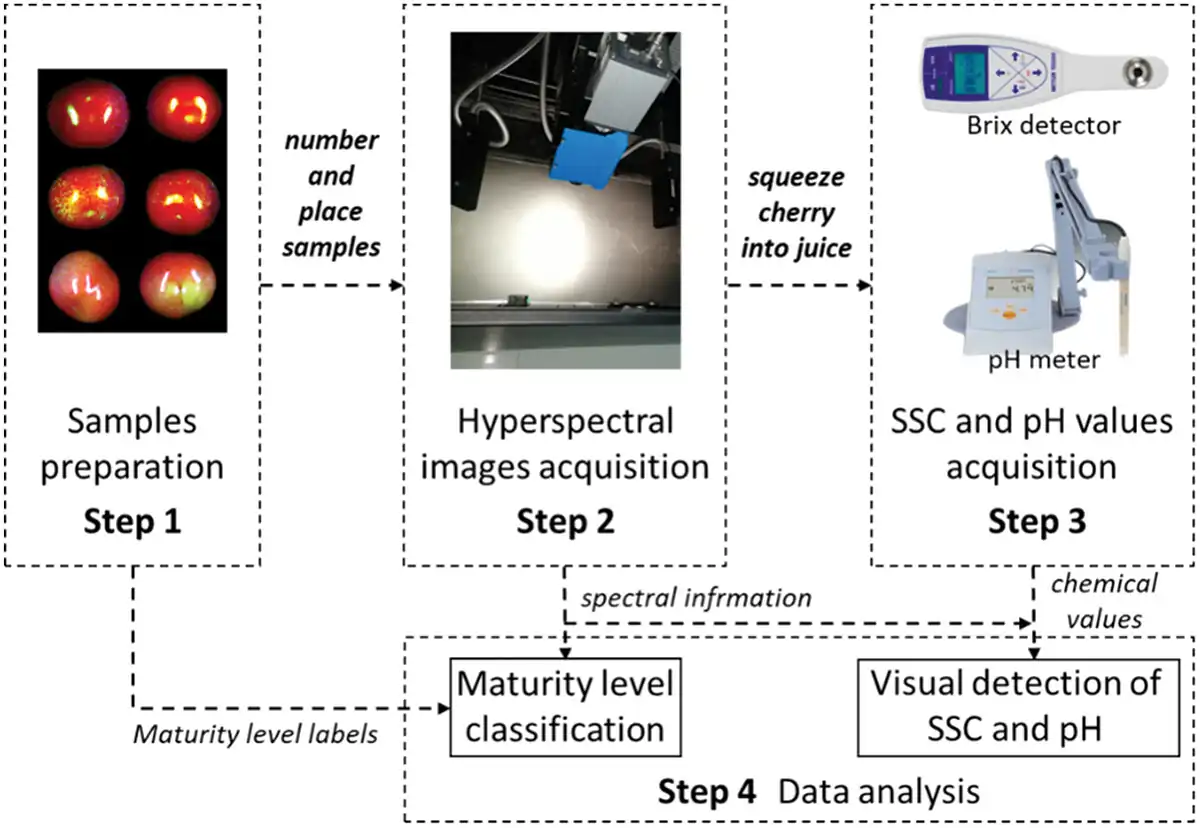Resilience key factor for cherry rootstocks
01 May 2023
A thoughtful choice of rootstock allows cherry trees to grow moderately, with a good dwarfing effect, produce well and adapt to critical conditions without compromising cherry quality.
Hyperspectral imaging can unlock the ripeness index of cherries. The two most important indicators in assessing cherry quality are their sweetness and acidity.
Commonly, the ripeness of the fruit is measured manually through destructive testing, which is inefficient and prone to errors. The chemical properties of cherries—particularly the content of soluble sugars, organic acids, and anthocyanins—are inextricably linked to their ripeness.
All of these compounds can also be detected through their reflectance spectrum, making it possible to classify the ripeness of cherries using this technique. The main goal of hyperspectral imaging technology is to develop a high-performance model that is complex, predictable, and stable.
In general, the effectiveness of the model can be improved through proper data preprocessing, feature extraction, and modeling methods. Hyperspectral imaging technology (with wavelengths between 380–1030 nm) was implemented in this study to visually identify the acidity and flavor of cherries.
Researchers from Huzhou University and Chongqing University (China) employed two spectral pretreatment methods to enhance the imaging performance. In addition, three feature extraction methods and four modeling methods were compared, with two of them showing the best performance after analyzing the hyperspectral imaging data.
 Figura 1. Processo operativo di acquisizione e analisi dei dati in questa ricerca
Figura 1. Processo operativo di acquisizione e analisi dei dati in questa ricerca
The waveforms of all the samples were largely consistent across the entire wavelength range. However, the reflectance intensity varied continuously. When the waveform represented the chemical structure and the reflectance intensity reflected the chemical concentration, the various cherry samples analyzed showed similar content values, yet differed in the concentration of that content.
The independent and identically distributed nature of the spectra provided a solid basis for establishing a regression model to predict the concentration of soluble solids and the pH values of cherries. The determination coefficients for the prediction of sugar content and acidity were 0.976 and 0.906, respectively.
Thus, excellent results were obtained, with classification accuracy approaching 100%. A detection protocol with comprehensive operational instructions was developed by analyzing the characteristics of various data analysis methods.
Additionally, improvements were made in some stages of the hyperspectral imaging technology. For example, the researchers enhanced the projection algorithm by identifying the initial band based on sample distribution rather than randomly and proposed a comprehensive convolutional neural network modelling method.
Classifying ripeness levels can improve the efficiency and accuracy of cherry processing, storage, and marketing, as visual detection provides significant convenience in quality evaluation. Moreover, the VNIR spectrum-based detection protocol is more practical for real-world application compared to NIR spectra, since the hardware required to acquire hyperspectral images in the visible range is easier to prepare.
This research provides a comprehensive and practical framework for evaluating quality and classifying the ripeness of cherries.
Source: Wei, Y., Yao, S., Wu, F., & Yu, Q. (2024). Maturity Classification and Quality Determination of Cherry Using VNIR Hyperspectral Images and Comprehensive Chemometrics. International Journal of Fruit Science, 24(1), 363–379. https://doi.org/10.1080/15538362.2024.2433238
Image source: Wei et al., 2024
Melissa Venturi
University of Bologna (ITA)
01 May 2023
A thoughtful choice of rootstock allows cherry trees to grow moderately, with a good dwarfing effect, produce well and adapt to critical conditions without compromising cherry quality.
16 Sep 2024
Recently, researchers at the University of Conceptiòn (Chile) evaluated the phytosanitary impact of bio-based defence programmes for the control of bacterial canker and fruit rots in pre- and post-harvest using bioproduct-based treatments (BPP1 and BPP2).
24 Dec 2025
Jessica Rodríguez analyses the problems of rot in Chilean cherries exported to China in 2024/25, highlighting causes, impacts and solutions adopted. The report highlights critical issues in post-harvest management, sanitisation and product storage.
24 Dec 2025
CMD-YOLO is a new lightweight and fast algorithm that detects cherry ripeness in real time. Developed in Yunnan, it overcomes the limitations of traditional methods, improving accuracy and speed for more effective and smarter precision farming.